RabbitMQ实战
基础
通讯
通讯分为同步和异步
- 同步就相当于是微信视频,实时更新,两个人只能够单线
- 异步就相当于微信聊天,不用实时回复,也可以同时和很多个人发消息
同步问题
- 同步调用在微服务中存在很多问题
- 耦合度高
- 性能下降
- 资源浪费
- 级联失败
异步调用
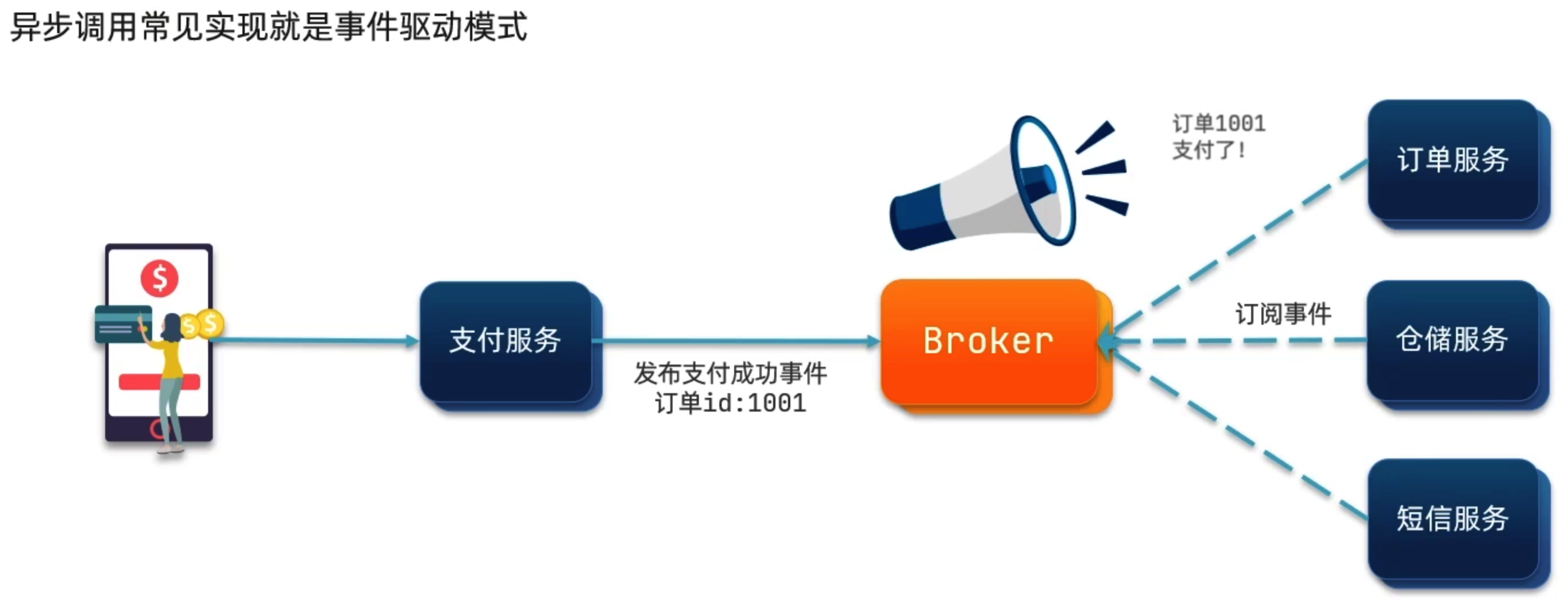
- Broker就是消息队列,只发消息
MQ
- MQ就是MessageQueue,消息队列,是事件驱动架构中Broker
安装
直接使用Docker进行安装
docker run \
-e RABBITMQ_DEFAULT_USER=aomsir \
-e RABBITMQ_DEFAULT_PASS=123456 \
-v mq-plugins:/plugins \
--name mq \
-p 15672:15672 \
-p 5672:5672 \
-d \
rabbitmq:3.8-management实践
HelloWorld
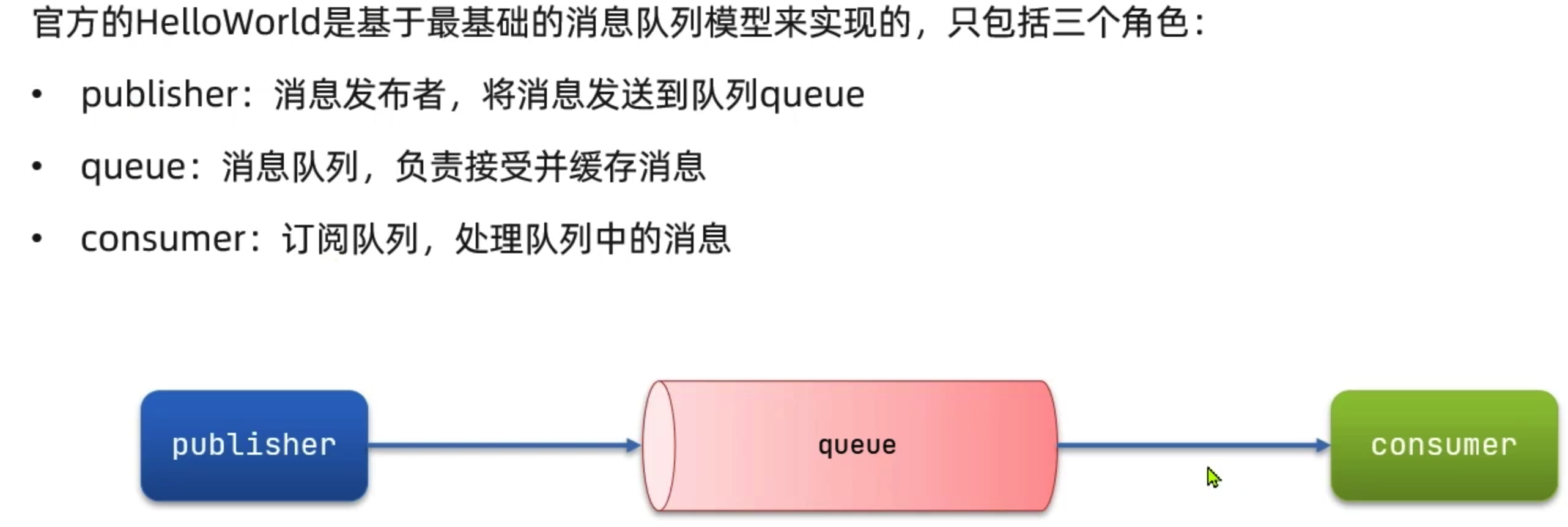
- 直接使用课程提供的demo
- 写两个测试类
public class PublisherTest {
@Test
public void testSendMessage() throws IOException, TimeoutException {
// 1.建立连接
ConnectionFactory factory = new ConnectionFactory();
// 1.1.设置连接参数,分别是:主机名、端口号、vhost、用户名、密码
factory.setHost("127.0.0.1");
factory.setPort(5672);
factory.setVirtualHost("/");
factory.setUsername("aomsir");
factory.setPassword("123456");
// 1.2.建立连接
Connection connection = factory.newConnection();
// 2.创建通道Channel
Channel channel = connection.createChannel();
// 3.创建队列
String queueName = "simple.queue";
channel.queueDeclare(queueName, false, false, false, null);
// 4.发送消息
String message = "hello, rabbitmq!";
channel.basicPublish("", queueName, null, message.getBytes());
System.out.println("发送消息成功:【" + message + "】");
// 5.关闭通道和连接
channel.close();
connection.close();
}
}
public class ConsumerTest {
public static void main(String[] args) throws IOException, TimeoutException {
// 1.建立连接
ConnectionFactory factory = new ConnectionFactory();
// 1.1.设置连接参数,分别是:主机名、端口号、vhost、用户名、密码
factory.setHost("127.0.0.1");
factory.setPort(5672);
factory.setVirtualHost("/");
factory.setUsername("aomsir");
factory.setPassword("123456");
// 1.2.建立连接
Connection connection = factory.newConnection();
// 2.创建通道Channel
Channel channel = connection.createChannel();
// 3.创建队列
String queueName = "simple.queue";
channel.queueDeclare(queueName, false, false, false, null);
// 4.订阅消息
channel.basicConsume(queueName, true, new DefaultConsumer(channel){
@Override
public void handleDelivery(String consumerTag, Envelope envelope,
AMQP.BasicProperties properties, byte[] body) throws IOException {
// 5.处理消息
String message = new String(body);
System.out.println("接收到消息:【" + message + "】");
}
});
System.out.println("等待接收消息。。。。");
}
}SpringAMQP

- 使用这个框架以后就可以简化MQ的使用,不向上面的操作那样
HelloWorld
- 引入依赖
- 写配置文件
- 消费者写监听配置类
- 写单元测试
<!--AMQP依赖,包含RabbitMQ-->
<dependency>
<groupId>org.springframework.boot</groupId>
<artifactId>spring-boot-starter-amqp</artifactId>
</dependency>
spring:
rabbitmq:
host: localhost
port: 5672
virtual-host: /
username: aomsir
password: 123456
@SpringBootTest
@RunWith(SpringRunner.class)
public class SpringAmqpTest {
@Autowired
private RabbitTemplate rabbitTemplate;
@Test
public void testSendMessage2SimpleQueue() {
String queueName = "simple.queue";
String message = "Hello, Spring AMQP";
rabbitTemplate.convertAndSend(queueName, message);
}
}
@Component
public class SpringRabbitListener {
@RabbitListener(queues = "simple.queue")
public void listenSimpleQueue(String msg) {
System.out.println("消费者接收到simple.queue的消息:【"+ msg +"】");
}
}
直接运行Application即可WorkQueue
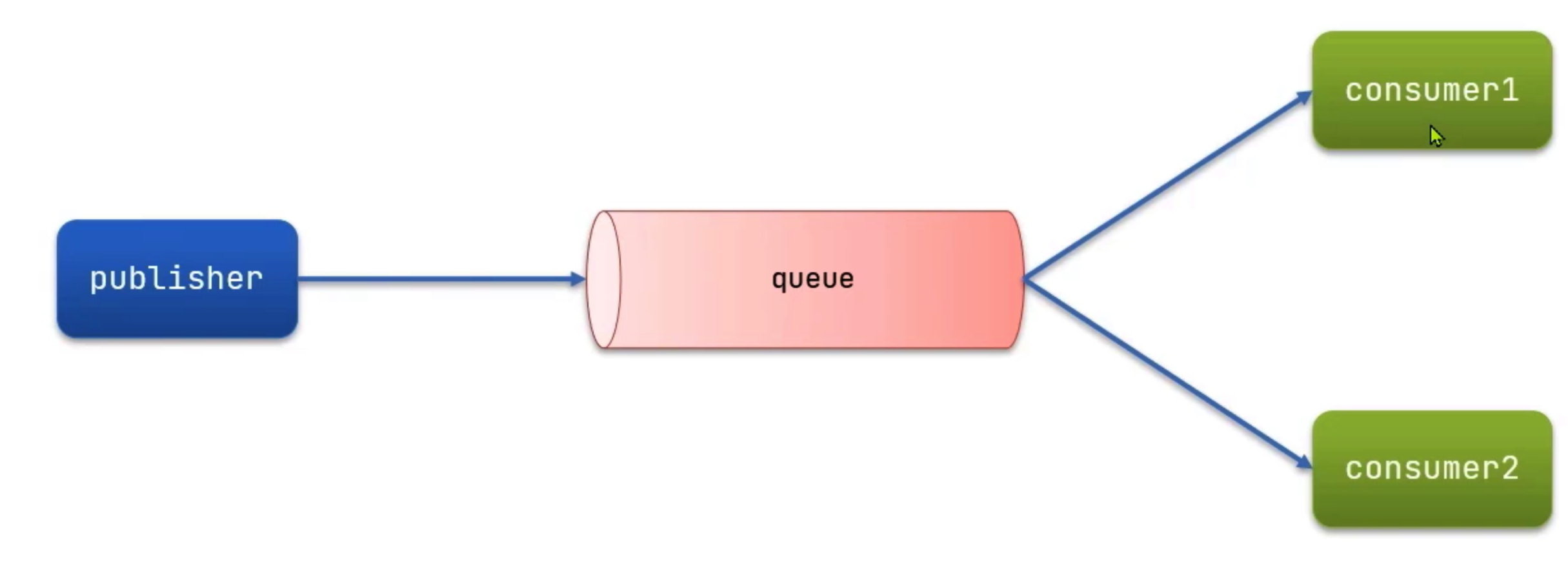
队列里的消息是阅后即焚的,只要有一个消费者接受救焚毁了

它的操作逻辑是轮询的,不会管你有没有处理完,所以会导致消费者堵塞,需要给消费者进行设置yml文件配置
- 这样的话时间就会压缩
@Component
public class SpringRabbitListener {
@RabbitListener(queues = "simple.queue")
public void listenWorkQueue1(String msg) throws InterruptedException {
System.out.println("消费者1接收到simple.queue的消息:【"+ msg +"】" + LocalTime.now());
Thread.sleep(20);
}
@RabbitListener(queues = "simple.queue")
public void listenWorkQueue2(String msg) throws InterruptedException {
System.out.println("消费者2接收到simple.queue的消息:【"+ msg +"】" + LocalTime.now());
Thread.sleep(200);
}
}
@Test
public void testSendMessage2WorkQueue() throws InterruptedException {
String queueName = "simple.queue";
String message = "Hello, message__";
for (int i = 0; i < 50; i++) {
rabbitTemplate.convertAndSend(queueName, message + i);
Thread.sleep(20);
}
}
logging:
pattern:
dateformat: MM-dd HH:mm:ss:SSS
spring:
rabbitmq:
host: localhost
port: 5672
virtual-host: /
username: aomsir
password: 123456
listener:
simple:
prefetch: 1 # 每次只能得到一条消息,处理完ACK后才能够获取下一个消息Publish/Subscribe
- 这是发布/订阅机制
- 和之前的区别就是:允许将同一条消息发送给多个消费者
- 实现方式:加入exchange交换机


@Configuration
public class FanoutConfig {
// 交换机
@Bean
public FanoutExchange fanoutExchange() {
return new FanoutExchange("aomsir.fanout");
}
// 队列1
@Bean
public Queue fanoutQueue1() {
return new Queue("fanout.queue1");
}
// 绑定交换机和队列1
@Bean
public Binding fanoutBinding1(FanoutExchange fanoutExchange,Queue fanoutQueue1) {
return BindingBuilder
.bind(fanoutQueue1)
.to(fanoutExchange);
}
// 队列2
@Bean
public Queue fanoutQueue2() {
return new Queue("fanout.queue2");
}
// 绑定交换机和队列2
@Bean
public Binding fanoutBinding2(FanoutExchange fanoutExchange,Queue fanoutQueue2) {
return BindingBuilder
.bind(fanoutQueue2)
.to(fanoutExchange);
}
}
@Component
public class SpringRabbitListener {
@RabbitListener(queues = "fanout.queue1")
public void listenFanoutQueue1(String msg) throws InterruptedException {
System.out.println("消费者1接收到fanout.queue1的消息:【"+ msg +"】" + LocalTime.now());
Thread.sleep(20);
}
@RabbitListener(queues = "fanout.queue2")
public void listenFanoutQueue2(String msg) throws InterruptedException {
System.out.println("消费者2接收到fanout.queue2的消息:【"+ msg +"】" + LocalTime.now());
Thread.sleep(20);
}
}
@Test
public void testSendFanoutExchange() {
// 交换机
String exchangeName = "aomsir.fanout";
// 消息
String message = "Hello everyone!";
// 发送消息到交换机
rabbitTemplate.convertAndSend(exchangeName,"", message);
}DirectExchange
- 发布订阅,交换机根据规则将消息路由到指定队列,称为路由模式
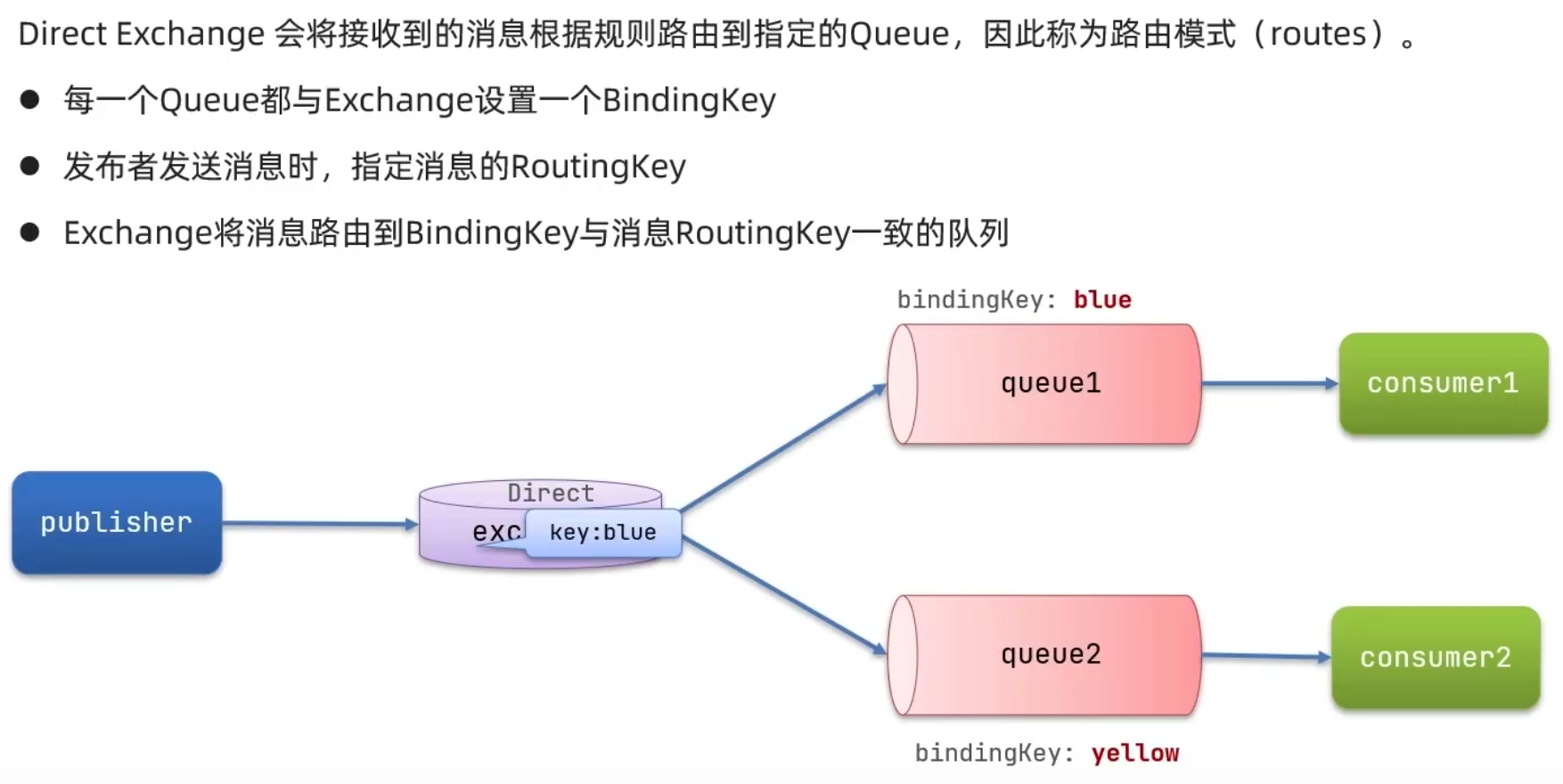

- 消费者直接使用注解的方式去声明交换机和绑定队列,不使用bean
- 发送消息的时候指定key
@Component
public class SpringRabbitListener {
@RabbitListener(bindings = @QueueBinding(
value = @Queue(name = "direct.queue1"),
exchange = @Exchange(name = "aomsir.direct", type = ExchangeTypes.DIRECT),
key = {"red","blue"}
))
public void listenDirectQueue1(String msg) {
System.out.println("消费者接收到direct.queue1的消息:【"+ msg +"】" + LocalTime.now());
}
@RabbitListener(bindings = @QueueBinding(
value = @Queue(name = "direct.queue2"),
exchange = @Exchange(name = "aomsir.direct", type = ExchangeTypes.DIRECT),
key = {"red","yellow"}
))
public void listenDirectQueue2(String msg) {
System.out.println("消费者接收到direct.queue2的消息:【"+ msg +"】" + LocalTime.now());
}
}
@SpringBootTest
@RunWith(SpringRunner.class)
public class SpringAmqpTest {
@Autowired
private RabbitTemplate rabbitTemplate;
@Test
public void testSendDirectExchange() {
// 交换机
String exchangeName = "aomsir.direct";
// 消息
String message = "Hello blue!";
// 发送消息到交换机
rabbitTemplate.convertAndSend(exchangeName,"yellow", message);
}
}TopicExchange
- 和DirectExchange类似,区别在于routingKey必须是多个单词的列表,并且以.切割
- 话题类型交换机
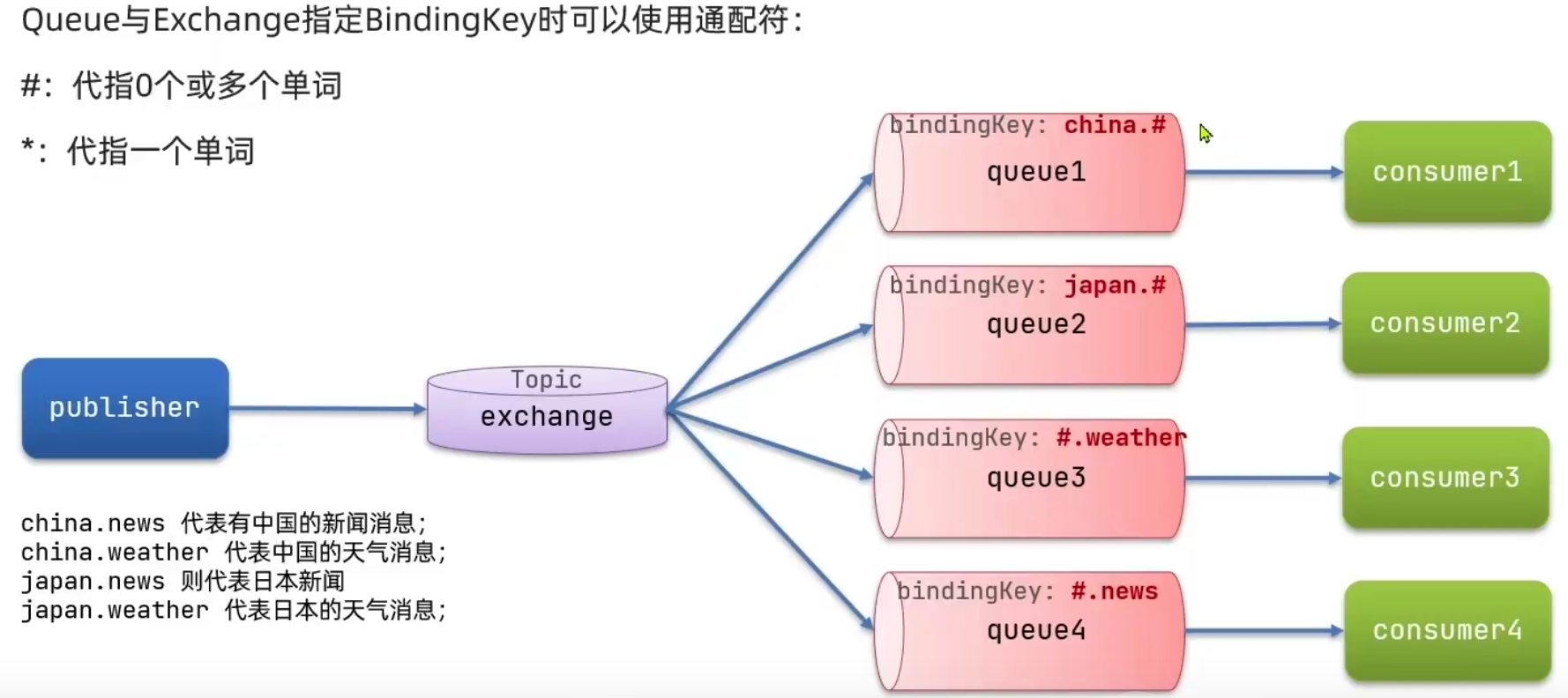
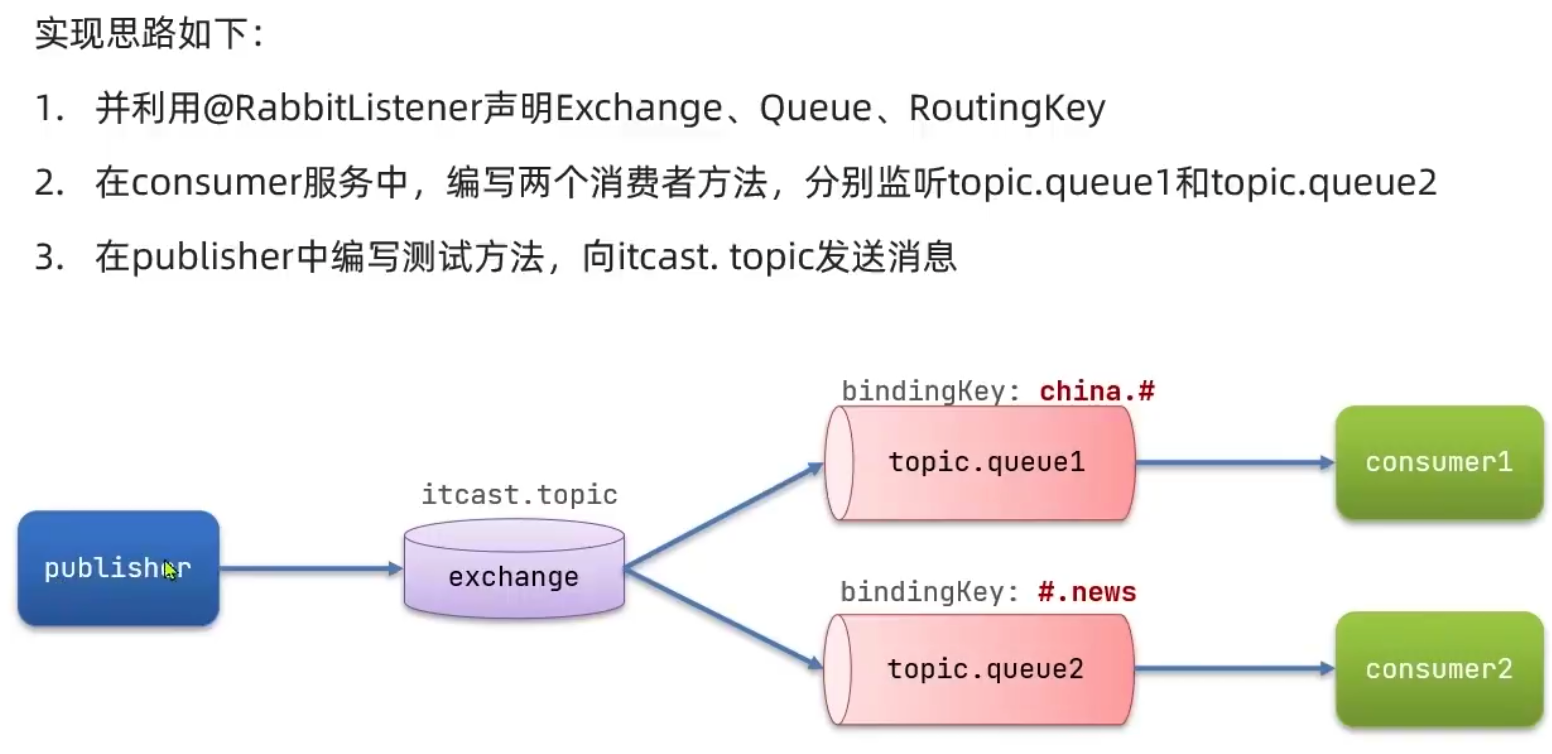
本博客所有文章除特别声明外,均采用 CC BY-NC-SA 4.0 许可协议。转载请注明来自 Jsckot的个人博客!


